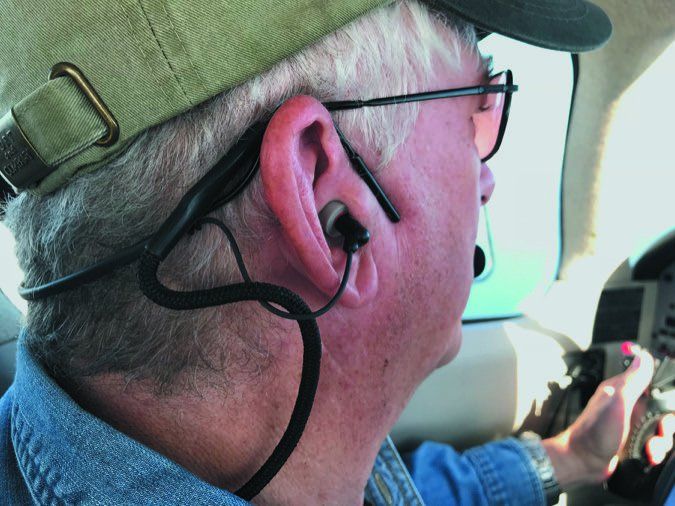The logical alternative to circumaural (over the ear) and supra-aural (on top of the ear) headsets is an in-ear design. These are basically ear buds attached to a thin head frame that also accommodates a traditional microphone. Their purpose is obvious and simple, which is to allow more freedom and comfort than you might experience wearing a traditional headset.
But that’s no easy task and there’s far more to consider than comfort. In-ear headsets should protect your hearing, provide audio clarity and performance as good as the highest-end ANR headset and they need to be rugged. Like any headset, they need to have a simple and compact control module.
To see which models do this the best, we rounded up three aviation-purposed in-ear headsets to include the Clarity Aloft Link, the Quiet Technologies Halo Tubephones and the Faro Air. Here’s a field report.
How We Evaluated
We put each of the three models on our bench and looked at design and build quality of the frames (some are bendable so we tried to snap them), the wiring protection, the audio plugs and supplied accessories. Face it, ear buds get nasty (and accumulated ear wax deteriorates performance), so a healthy supply of fresh replacement buds in various sizes is high on our list of gotta-have parts. And as we learned a long time ago with traditional headsets, not every noggin is the same, so the ability to precisely adjust the frames for just the right fit when wearing a hat, eyeglasses and maybe even a flight helmet is important.
We’ve always advocated trying any headset before you buy it. Understand that in-ear headsets aren’t for everyone because some simply can’t tolerate buds in the cabin environment—especially unpressurized ones. See the sidebar on page 8 for custom ear mold alternatives. Based on our use, in-ears might not work to your liking in loud cabins, including open cockpits. We know they work quite we’ll in jets and turboprops. For these missions, we bring along our own Clarity Classic model.
For performance comparison with a circumaural ANR design, we used the Bose A20 Bluetooth model as the benchmark for entertainment audio quality, since all of the in-ear models evaluated here accommodate music.
Clarity Aloft Link
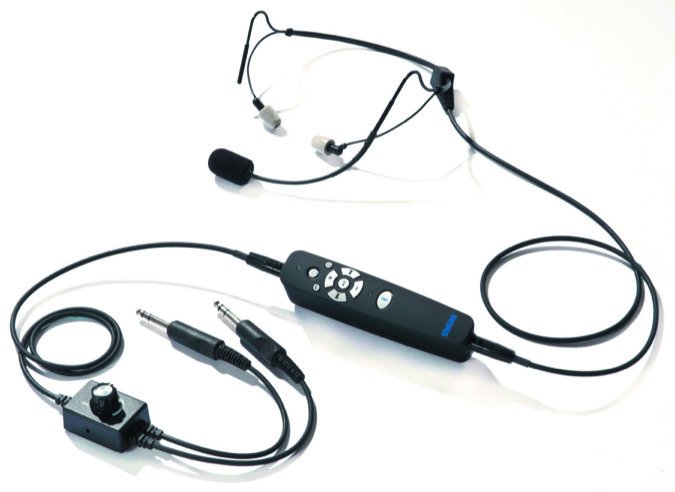
The Clarity Aloft line consists of three available versions of in-ear headsets offered by Minnesota-based Aloft Technologies. The models—Classic, Link and Pro Plus—differ either by having wireless Bluetooth capability or FAA TSO certification. More on this in a bit.
The set we used in this roundup is the Link, plus the $525 Classic model. Weighing just shy of 2 ounces, the Clarity Classic (which weighs the same as the others in the Aloft lineup) isn’t the lightest and that’s obvious when it is on the head. But out of the sets we evaluated, we think it feels the most durable. The hardware—including the headband and attached microphone boom—have a high-end feel.
The Clarity is worn over the ears and the band rests behind the head. There is some flex in the band to adjust it for a more precise fit, while the microphone always seemed to stay in just the right position over the lips without dropping or moving out of the way. We use the Clarity with and without glasses and hats and it always fits we’ll without struggle.
All Clarity models come with what Aloft calls Comply Canal Tips. These foam tips come in small, medium and large and screw onto threaded posts of the set’s speakers. We wouldn’t believe it unless we tried them, but Aloft advises that you may need different size tips for each ear. That was the case with more than one evaluator who needed a small tip in the left ear and a medium one in the right. You’ll want to experiment because if you don’t get a full seal (with any of these in-ear headsets), performance will indeed suffer. You also have to properly insert the tips and that may not be easy for all.
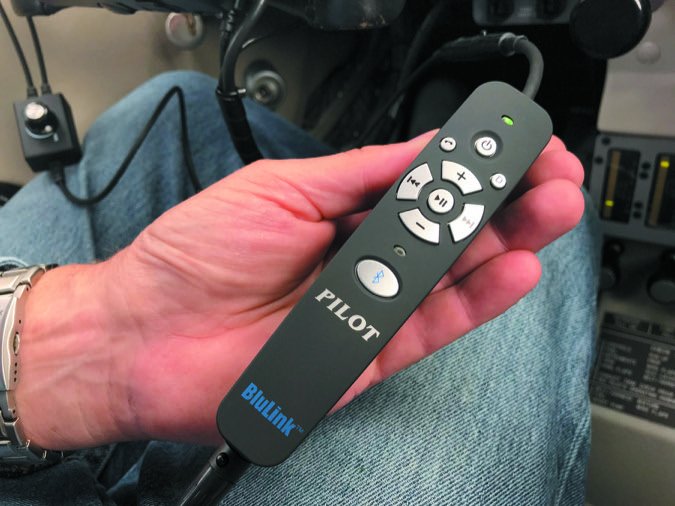
Aloft instructs you to compress the foam by pinching it down, as opposed to rolling it. That can cause the tips to unscrew from the posts, it can stress the wires and also risk lodging the tip in the ear. The average canal tip lifespan when used daily can be up to three months, but waxy ears have us changing them far more often.
We found the Clarity’s audio quality and noise attenuation impressive. Aloft says you can expect between a 29- to 47-dB noise reduction within the 125 to 8000 Hz frequency spectrum—that’s nearly as effective as higher-end ANR models.
The directional noise-cancelling microphone also performed flawlessly. It never clipped and it was as crisp and clean as the mic on the Bose A20 or Lightspeed Zulu 3. But keep the correct side to your lips—there’s only one “talk” side.
The volume control box is minimal and houses a single volume control knob, plus a stereo/mono switch. There’s also a balance control potentiometer on the back of the box. While left and right channel balance is pre-adjusted at the factory for center balance, you can tweak the pot for more or less volume in either ear. This might be handy when used with a PS Engineering or Garmin audio panel that has dimensional sound, where audio is spatially positioned in the headset.
There is a music input jack on the control box for external wired audio input. While the music quality was quite good, it doesn’t mute when there’s radio or intercom chatter.
The $795 Clarity Link model has all of the same features and specifications as the Classic, but with a detachable Bluetooth module for wireless music and telephone audio input. Aloft doesn’t build the BluLink module, but instead sources it from Pilot-USA. While the BluLink module has intuitive controls and a high-end feel, we wish it had an extension cable for more storage options in the cockpit. Weighing 4.2 ounces with two AA batteries installed, the BluLink tends to tug on the headset’s audio cables if it isn’t resting on something—like the aircraft floor or secured in a map pocket. Even the supplied attachment clip wouldn’t keep the module secured where we wanted it in flight.
Of course, you don’t have to use the BluLink module. The device has two quick-connect attachment points: One side connects with the volume control box and the other connects directly with the headset.
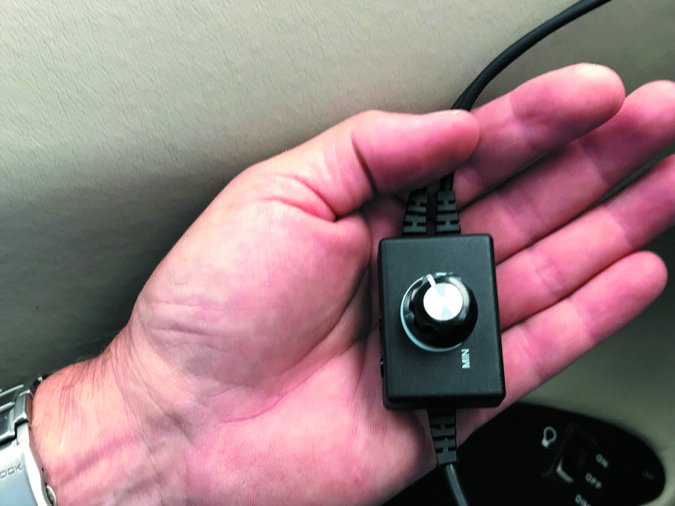
Pairing the BluLink with a newer iPhone was easy and there’s a dedicated pairing request key on the face of the module, along with a Bluetooth status annunciator. There’s also a power annunciator and a simple on/off key.
The quality of the music linked through the module was outstanding, in our view. The module has Digital Signal Processing (DSP) and our ears sensed an increase in audio gain and depth when the circuit energizes. Better yet, volume keys allow you to control the music level separate from the main Bluetooth source, plus you can advance or rewind through the song playlist with dedicated keys on the module. You can answer the connected telephone with the dedicated telephone key.
The BluLink comes preset to reduce the volume of the linked music when there’s radio or intercom chatter, but you can make it mute entirely by pressing and holding the phone icon on the module for three seconds. Depending on how much Bluetoothing you do, battery life is listed as 15 to 20 hours, and it has automatic shutoff after 30 minutes when it’s not connected to a Bluetooth source.
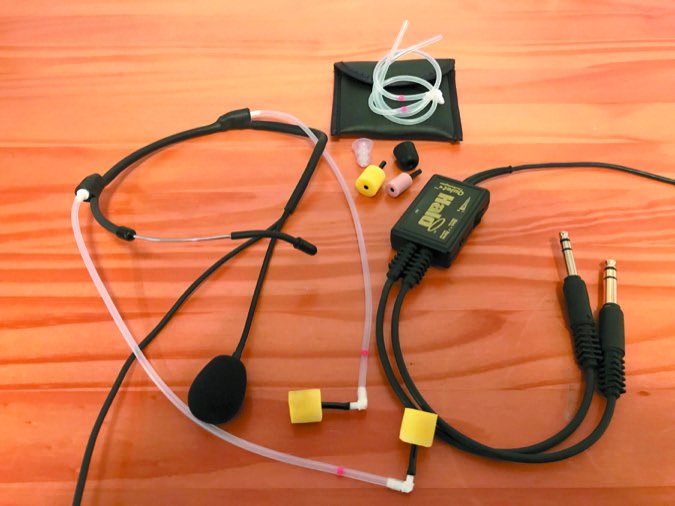
Aloft also offers a TSO’d version called the Pro Plus. It says the target market for the $725 model (which doesn’t have the BluLink module) is airline crews requiring TSO’d headsets. These are manufactured in a different location than the other Clarity models (because of the stringent TSO standards) and utilize a slightly different microphone with a heavier boom.
All Clarity models come with a storage case, six pairs of small, medium and large ear tips, plus a three-year warranty and 30-day money-back guarantee.
Quiet Technologies Halo Tubephones
Maker of the $359 Halo, Mississippi-based Quiet Technologies boasts that it was the first company to develop a lightweight insert-style noise isolating foam tip headset for aviation. Company founder Phil McCandless said the design dates back more than 20 years ago as the UltraFlite and AuriComm models. The UltraFlite and the current Halo concept arose by studying the Etymotic Research ER-series insert earphones used by audiologists in clinical and research labs.
The basic Halo design—which is really an Etymotic Research ER-3 earphone fitted with an aviation-compatible noise-cancelling microphone—utilizes a balanced-armature speaker that delivers sound to the ear through a carefully designed “tuned” tube network inside a small box. The sound travels through the acoustic tubing network, exiting the box through a foot-long tube and out of a soft compressible foam ear tip sealed to the ear canal.
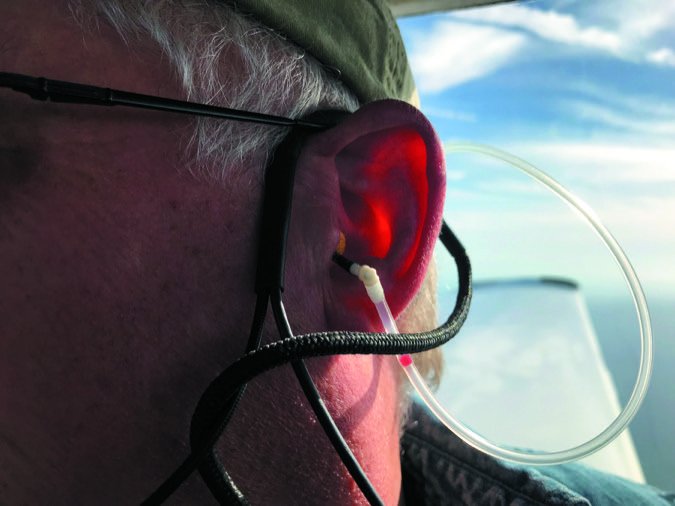
McCandless says studies show that significant noise isolation (attenuation) is possible using the ER earphones and can equal or exceed that of a single-walled audiometric test enclosure. This allows the audiologist to test patients down to the quietest threshold levels in typical physician examination rooms without the need to place the patient inside a massive and expensive noise-isolating test suite while wearing conventional earphones.
There’s no fancy electronics here, which frankly gives the Halo a dated feel compared to the others in the group. But what the Halo lacks in gee-whiz design, it could make up for in reliability. McCandless said the advantage of using tubes in the Halo (instead of a direct earphone driver into the ear) is obvious. Tubes are simple devices, requiring no wires or electricity, and when they become defective or clogged they can be replaced in the field by pulling the old ones off and slipping new tubes on. The Halo comes standard with replacement tubing.
Since the Halo can be worn either over the head, behind the head or rested on the shoulders, the tubes can be cut almost an inch for a better fit, depending on how you wear the set. For instance, longer tubes accommodate the frame resting on the shoulder (making the set more awkward, in our view), while shorter ones work best when the headset is worn behind the head. Still, it’s easy for the dangling tubes to get caught under the headband or even snagged on a shoulder seatbelt.
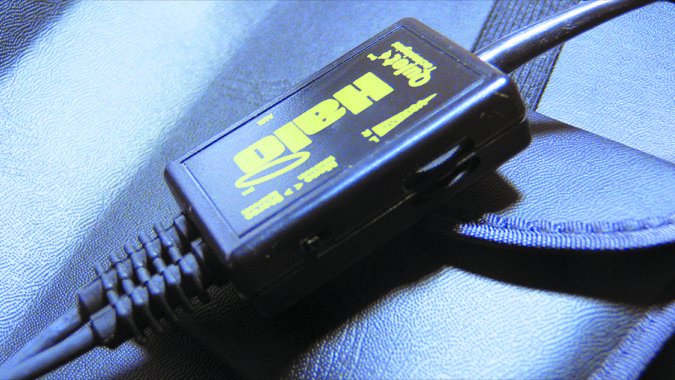
The headband is flexible, and pulling or pushing on the stainless steel rod (which is contained inside a hollow portion of the headframe) allows for a fit that works best for your head shape and size. We tried all three fitting positions.
Wearing the set over the head seemed uncomfortable and made them unstable, if not difficult to wear with a ballcap. Worn on the shoulder, the microphone seemed to move out of position. Wearing the Halos over the ear worked best in our trials, easily accommodating glasses and a ballcap.
The tubes, according to Quiet Technologies, are critically damped and optimize speech and music (the headset accommodates a wired entertainment input—no Bluetooth) by restoring the natural resonant characteristic of an unblocked ear canal. We found the audio quality to be acceptable. The real test is with music piped in from an iPhone. The Halos, in our opinion, performed the worst out of the three headsets tested. But admittedly, this is with a critical ear.
The music input gain was low (even with the source cranked way up) and the set lacked the bass response that we enjoyed on the Clarity—and have grown to love on the Bose A20. Not even close.
The noise-cancelling microphone’s sensitivity didn’t seem to be as good as the one used on the Clarity, either. With the Halo, it has to be positioned precisely over the lips to avoid clipping.
As for the ear tips, the Tubephone can be used with triple-flange rubber inserts or disposable foam inserts. In our trials, the foam tips seemed to offer the best noise isolation. You can compress them better than any of the other tips, which is the key to the best attenuation. Once in the ear and fully expanded (which takes a few seconds), we found them to be comfortable and extremely effective.
The Tubephone has a basic control module (the set doesn’t require batteries) that houses a stereo/mono switch and thumbwheel potentiometers for adjusting volume. No frills here. We do like the Kevlar reinforced audio cables that the company says are high strength and UV-resistant. They are routed into the hollow headband, which keeps them out of the way.
Quiet Technologies said it is still producing the Halo, but as we go to press it has suspended new orders due to product backorder. The company only fields questions and correspondence via email and you can’t leave a message. In our dealings, the demo set arrived promptly.
Faro Air
Despite brisk competition in the entry-level headset market, Las Vegas-based Faro Aviation has made inroads with several models, including the in-ear Air. The $390 Faro Air (along with a Clarity) has been in our long-term evaluation pool for roughly one year and we’ve been offering them to passengers and other pilots for feedback.
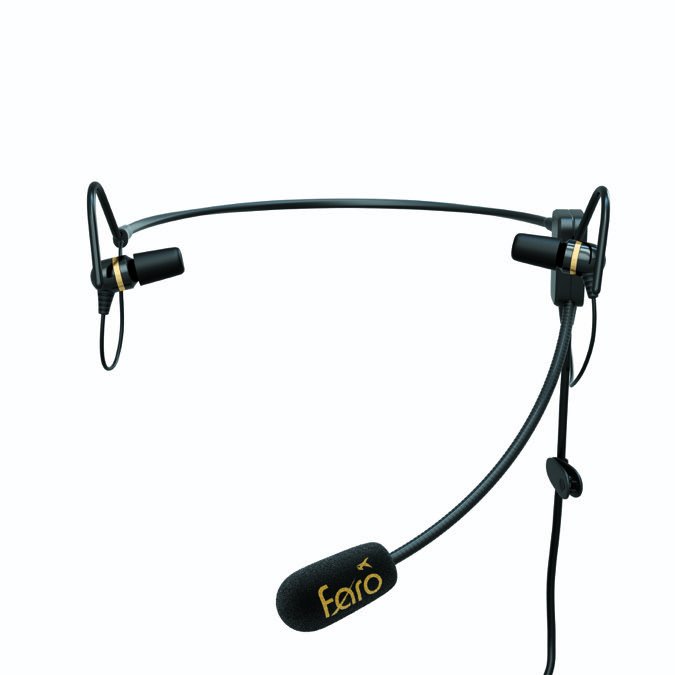
One pilot used them in his Arcus glider during a multi-day competition. The draw? A traditional over-the-head headset can break the aircraft’s canopy when jarred in turbulence. Problem solved with an in-ear model. Unfortunately, the same evaluator reported what seemed to be an impedance-related audio problem when used with a passenger on the intercom. The problem was solved by using a different headset.
The Faro is comfortable and at 1 ounce, it’s .5 ounces lighter than the Clarity. This might seem nominal, but the Air just felt easier to wear on longer hauls and there were no pressure points where the earband rests on the base of the ear. It helps that the headband doesn’t need to fit tightly on the back of the head to stay firmly in place.
Don’t look for slide adjustments on the metal headband and earloop

frames—they don’t exist. Instead, you simply bend the metal (expand or contract) to get the right size for your head. Faro says you won’t break the structure by making these adjustments, and if you do, the company will exchange the set. And you likely will have to do lots of adjusting.
One staffer dinged the Airs for being too loose on the head without sizable tweaking, and he thought the microphone felt heavy hanging off the frame.
But we think the Airs have the best foam ear buds in the group. This means they’re comfortable in the ears and offer decent sound isolation. Our takeaway is the same as it’s been in other in-ear headset trials. The performance of either in-ear model is greatly dependent on the fit of the slow-recovery composite foam earplugs. Faro provides two sizes to choose from: medium (Faro says the medium fits the majority of users) and large. Both are designed slightly longer than a typical earplug to fit deeper into the ear canal.
Faro says the Air provides up to 50 dB of noise reduction. Compare that to the Clarity Aloft, with specs rated at up to 49 dB of noise attenuation. But, for perceived audio quality, we prefer the Clarity. The Faro is accepatble, but we think the Clarity beats it in depth and tone.
Still, we like simplicity and the Faro’s lightweight control module delivers. It has a slide volume control for each ear that proved to have a linear adjustment, plus there’s a stereo/mono slide switch that’s easy to get to. But, the cutouts for the volume sliders seemed too exposed, potentially susceptible to trapping dust and other contaminants over time.
There is a mono/stereo selector switch nicely positioned on the face of the control module. What you won’t find on the module is controls for Bluetooth. The only way to pipe music into the set is to connect an audio patch cable from the music device to the module, like the Halo.
Do Custom Ear Molds Still Make Sense?
Of course I tried circumaural headsets years ago, but the pressure and bulk caused me discomfort and gave me headaches on long trips. The lightest headset at the time was made by Plantronics and was used by airline pros. I ordered a Plantronics model MS50/T30-2, but I didn’t like the ear- piece that came with it so I adapted and mounted a firearms ear plug to the ear tube. I used this for years until I found a place that could make a custom ear mold for it. By eliminating the headband, the comfort level was increased exponentially. When Lightspeed came out with the Mach 1 stereo headset, I bought one with the custom ear mold option. The audio was much better, with both ears processing sound, plus the microphone was also a notch up in quality.
Today, the process is simple for getting custom ear molds for use with most in-ear headsets. The first step is to find an audiologist to get an ear mold fabricated. That’s one in the inset photo to the right. Then you send the molds out to a company that makes the finished ear inserts. They’ll customize the inserts to attach them to the specific headset you have purchased. The process generally takes a couple of weeks.
I always find vendors at Sun ‘n Fun and AirVenture offering custom on-the-spot ear molds, but a web search generally turns up fewer options. One reputable mold maker is Avery Sound in Capo Beach, California. Its website is www.pilotstuff.com, which has a pilot-oriented section for custom mountings for a variety of headsets available today. The company I originally used for fitting to the Mach 1 ear molds was Sensaphonics in Chicago. Its website is www.sensaphonics.com.
But should you even mess with modifying something as good as a Clarity Link? I liked the build and audio quality so much I’m considering them and a custom mold. Aloft’s Mike Feldbauer—an audio specialist—warned of some caveats. For example, the human body is flexible and when an ear mold is taken, the ear canal is in one state. The canal opening may be smaller or larger depending on the ambient temperature and other physical factors such as water retention, weight and diet. Think in terms of a finger ring—sometimes it slides right off, other times it’s stuck. Similarly, the custom ear mold may be loose on some flights, which would let in some ambient noise. Aloft doesn’t recommend using custom ear molds with its Clarity headsets because they can’t guarantee the same noise attenuation with them as they can with the audio foam they use. It has also seen cases where the molds damage the threads on the speaker attachment posts.
After buying custom molds, I never looked back and have been flying all kinds of aircraft, including my Mooney, with huge comfort on long trips. The stereo audio quality has been very good and ambient noise is reduced considerably. But, I was so impressed with the audio quality of the speakers in the Clarity Link headset that I’m starting to think it’s time to upgrade and ditch the molds for foam.
An Easy Winner
We like the build quality, audio quality and fit of the Clarity Link the best, although we don’t think you should have to pay extra these days for Bluetooth capability. At $795, the Link comes at a $270 premium over the Classic model.
The runner up is the Halo. We think it has good audio quality and it’s a fair price at $359. We’re concerned, however, about the company not accepting new orders.
Last, as with any headset, we strongly suggest trying before buying.

